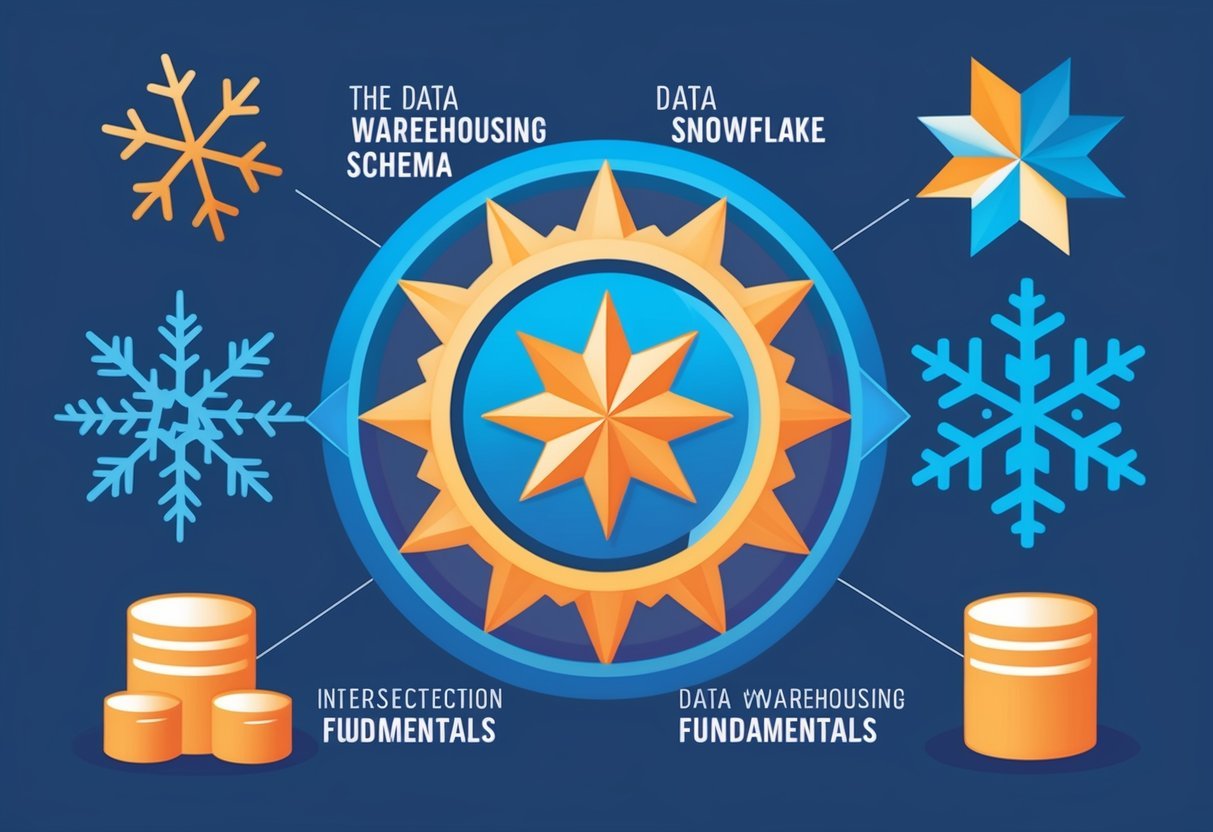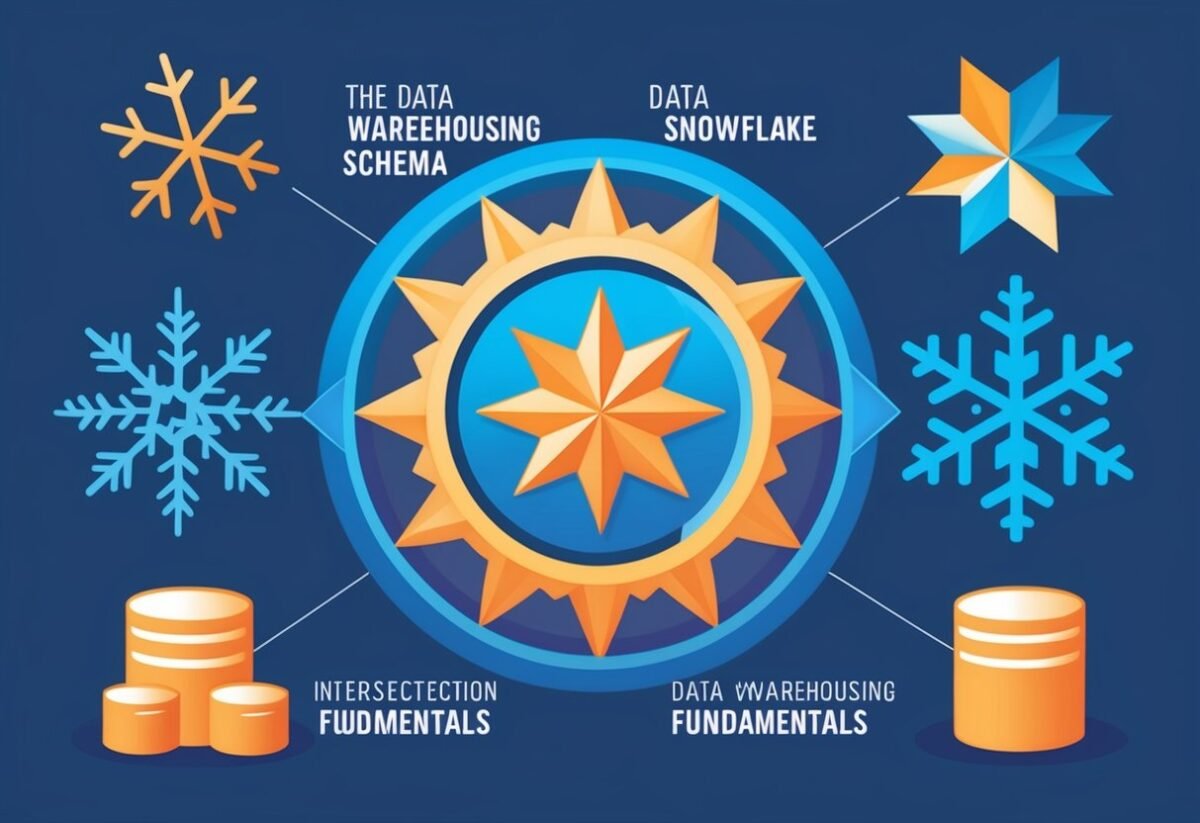Understanding Star Schema
The star schema is a popular database structure used in data warehousing for organizing data. It consists of a central fact table linked to dimension tables, offering simple design and fast query performance.
Characteristics of Star Schema
The star schema is a straightforward model based on a central fact table connected to various dimension tables. This design is known for its simplicity.
The structure is denormalized, meaning data redundancy is intentionally increased to enhance query speed. This denormalization leads to improved performance, particularly in read-heavy operations, making it ideal for reporting and analytical tasks.
Additionally, the star schema allows for intuitive data slicing and dicing, providing users with clear pathways to access necessary information efficiently.
Components of Star Schema
The main components of a star schema include the fact table and several dimension tables.
The fact table holds quantitative data such as sales or revenue amounts and includes keys that reference related dimension tables.
Dimension tables, on the other hand, store descriptive information like dates, locations, and product details.
Each dimension contains a primary key that links to the corresponding foreign key in the fact table, establishing relationships essential for query execution.
Advantages of Star Schema
A key advantage of the star schema is its impact on query performance. With fewer joins needed compared to more complex models, data retrieval is typically faster. This efficiency benefits data warehouses where quick access to data is necessary for business intelligence tasks.
The simplicity of the star schema design also translates into easier maintenance and flexibility, allowing analysts to make changes without intricate restructuring.
Disadvantages of Star Schema
While the star schema offers many benefits, it does have some disadvantages.
The denormalization process can lead to increased storage requirements due to data duplication in dimension tables. This might result in higher storage costs, particularly as data volume grows.
Additionally, the simplicity comes at the cost of flexibility in scenarios demanding complex analytical queries, where more intricate schema designs might be needed for optimal results.
Exploring Snowflake Schema
The snowflake schema stands out with its complex structure, characterized by normalized dimension tables and reduced data redundancy. This design leads to specific advantages and disadvantages, particularly in terms of storage and query performance.
Characteristics of Snowflake Schema
The snowflake schema features a fact table connected to multiple normalized dimension tables, resembling a snowflake shape. This structure normalizes data into sub-tables, removing redundancy and organizing information in a more detailed manner.
Dimension tables are broken down into further tables, which allows for efficient storage and access to hierarchical data.
This approach contrasts with flat designs like the star schema, offering more granular data representation.
Complexity and Normalization in Snowflake Schema
Normalization in snowflake schemas reduces data redundancy by dividing large tables into smaller, related tables. This normalization, while reducing storage needs, adds complexity to database design.
It involves more tables and foreign keys, leading to intricate relationships between tables.
Such complexity requires more sophisticated query techniques and can increase query complexity. This complexity can impact performance, especially for complex queries involving multiple joins across various tables.
Advantages of Snowflake Schema
The snowflake schema offers several advantages. The highly normalized structure greatly reduces storage requirements, especially beneficial in scenarios with large data volumes and hierarchical datasets.
With less redundancy, data maintenance becomes easier, allowing for simpler updates and modifications.
The schema supports intricate hierarchies and complex datasets due to its organized data structure. These strengths make it useful in advanced data warehousing and analysis tasks involving comprehensive data models.
Disadvantages of Snowflake Schema
The primary drawbacks of the snowflake schema stem from its complexity. Increased normalization demands more technical understanding and can complicate query processes.
Queries that navigate through many tables can be slower and more complex, affecting performance and resource use.
Moreover, the intricate relationships and numerous joins can make the schema less user-friendly for non-technical users. This complexity can lead to a steeper learning curve and require more training for efficient use.
Data Warehousing Fundamentals

Data warehousing is crucial for managing large volumes of structured data and is a vital component of business intelligence. It supports decision-making by facilitating data integration and analytics through the ETL process.
Defining Data Warehousing
Data warehousing involves collecting, storing, and managing vast amounts of data from various sources within an organization. It provides a central repository where data is organized in schemas, like star and snowflake, enabling efficient data retrieval and analysis.
This system is designed to support analytical reporting and decision-making, not transactions. Data within a warehouse is often subject-oriented, integrated, and non-volatile, serving as a historical record for business intelligence activities.
Role in Business Intelligence
In business intelligence, data warehousing plays a pivotal role by providing the foundational architecture for analytics and reporting tools.
It ensures that data is clean and well-organized, enabling accurate analysis and insights.
Businesses use this consolidated data to track trends, measure performance, and support strategic decision-making processes.
Through the integration of disparate data sources, warehousing enhances the ability to generate comprehensive reports, dashboards, and other tools that drive informed business decisions.
ETL Process and Data Integration
The ETL (Extract, Transform, Load) process is essential in data warehousing for data integration.
It involves extracting data from different sources, transforming it into a standard format, and loading it into the warehouse.
This process ensures that only high-quality, reliable data is available for analysis and reporting.
By maintaining data integrity, ETL supports consistent business intelligence outputs.
Organizations rely on ETL to blend data across various systems, allowing seamless access to unified information necessary for analytics and decision-making.
Schema Design Considerations

Choosing the right schema design is crucial for database performance and management. It involves decisions about normalization, data integrity, redundancy, and how the schema can evolve over time. These elements are key in determining the effectiveness of star and snowflake schemas.
Normalization Vs Denormalization
Normalization focuses on reducing data redundancy and improving data integrity by organizing data into tables. It is typical in snowflake schemas where dimension tables are more subdivided.
On the other hand, denormalization is about improving query performance by including redundant data, commonly seen in star schemas. This approach helps in speeding up read operations, as fewer joins are needed when querying data.
Both methods have their pros and cons. Normalization often leads to better data organization and consistency, but it might slow down query performance due to the need for joining multiple tables. Denormalization offers faster query time but at the expense of higher data redundancy.
Data Integrity and Redundancy
Data integrity ensures that data is accurate and consistent. In normalized schemas, maintaining data integrity is simpler because changes to data need to be made in fewer places. This can be crucial for systems requiring high accuracy and reliability.
Denormalized schemas trade some level of integrity for performance. They often have duplicate data in several places, which can lead to data anomalies and inconsistencies if not managed carefully.
However, this redundancy often results in improved performance for read-heavy databases because it reduces the number of joins needed.
Designers must carefully balance integrity and redundancy to align with the system’s needs.
Schema Evolution Strategies
As databases grow, their schema may need adjustments. Schema evolution involves modifying the schema without disrupting existing data and applications. Strategies vary based on whether the schema is normalized or denormalized.
Star schemas are typically more adaptable to change due to their simpler structure. They can handle added fields or new tables with less disruption.
Snowflake schemas, being more complex, might require more thoughtful planning and execution when changes are necessary.
Flexibility and scalability are crucial in evolving schemas. Selecting a strategy that supports easy updates and changes without compromising performance is essential for long-term success.
Tables in Star and Snowflake Schemas

Star and snowflake schemas organize data to optimize analysis. Both schemas feature central fact tables connecting with dimension tables, but they differ in structure and design complexity.
Designing Fact Tables
Fact tables are pivotal in both star and snowflake schemas. They store quantitative data such as sales figures and transaction amounts.
The star schema’s fact table is centralized and links directly to dimension tables, optimizing performance.
In contrast, snowflake schemas often involve more layers, connecting through additional sub-dimension tables. This can introduce complexity but may offer storage efficiency.
A key focus is ensuring that fact tables are sufficiently granular, allowing for detailed data analysis while maintaining efficient storage.
Utilizing Dimension Tables
Dimension tables hold attributes like product information, dates, or customer details.
In a star schema, these tables are denormalized and directly linked to the central fact table. This simplicity boosts query performance by reducing joins.
In snowflake schemas, dimension tables are more normalized, dividing information into separate sub-tables.
This structure can enhance data integrity and reduce redundancy but may require more complex queries. The trade-off between simplicity and normalization impacts design choices based on performance and data quality needs.
Handling Granularity and Hierarchies
Granularity determines the level of detail within fact tables. High granularity provides detailed insights but requires more storage.
Both schemas must balance detail with database performance.
Hierarchical structures are more prevalent in snowflake schemas due to their normalized nature. They allow for detailed, complex relationships between data points.
In star schemas, hierarchies are typically simpler, focusing on direct relationships to the central fact table. The choice affects data navigation and analysis flexibility.
This balance between granularity and hierarchies is crucial for efficient data analysis and system performance, ensuring that the data structure aligns with analytical requirements.
Performance and Query Optimization

Performance in data schemas is crucial for anyone working with analytical queries. The choice between star and snowflake schemas can greatly influence query speed and optimization strategies. This section looks at how schema design affects analytics and touches on key techniques to boost query performance.
Improving Query Speed
Query speed is essential in business intelligence (BI) for quick insights.
Star schemas can enhance query performance due to their denormalized structure. This setup reduces the number of necessary joins, making it faster to retrieve data.
In contrast, snowflake schemas are more complex, requiring multiple joins across normalized tables. This could slow down the query execution, but it offers benefits in complex data environments where storage efficiency is key.
Table: Comparison of Star and Snowflake Schema Speed
| Schema Type | Join Complexity | Query Speed |
|---|---|---|
| Star | Low | Faster |
| Snowflake | High | Slower |
Query Optimization Techniques
Effective query optimization is achieved through careful schema design.
For star schemas, indexes on fact tables can significantly boost performance by speeding up common OLAP queries. Ensuring that dimension tables are small and efficiently structured further aids this.
In snowflake schemas, query optimization is more intricate. Techniques include leveraging indexed views and materialized views to pre-compute joins.
Additionally, partitioning large dimension tables can help manage performance in a snowflake schema, resulting in reduced query run times and better data analysis support.
Impact of Schema on Analytics
The chosen schema impacts the effectiveness of analytics.
Star schemas, due to their structural simplicity, often cater to standard reporting needs, making them ideal for straightforward BI tasks. They excel at handling large-scale data swiftly, crucial for many business scenarios.
Snowflake schemas, with their ability to handle high-dimensional data, are suitable for complex analytical scenarios. They offer storage savings, though at the expense of increased query times.
This makes them best for environments where data complexity outweighs speed as a priority, enhancing the depth of data analysis in sophisticated analytics tasks.
Storage and Maintenance

The choice between star and snowflake schemas significantly impacts storage requirements and maintenance approaches. Understanding these differences can guide effective schema design.
Storage Costs and Efficiency
Star schemas use a denormalized data structure, which can lead to higher storage costs due to data redundancy. This means the same data is stored in multiple places, increasing storage requirements.
However, this structure can simplify queries, as fewer joins are needed.
Snowflake schemas, on the other hand, use normalized data. This minimizes redundancy by breaking information into smaller related tables. As a result, snowflake schemas generally have better storage efficiency compared to star schemas because they reduce data duplication. This approach can save storage space, particularly when dealing with large volumes of data.
Challenges in Schema Maintenance
Maintaining a snowflake schema can be complex. It involves managing multiple tables and their relationships, which can make updates and modifications more intricate. It often requires careful coordination to ensure consistency across the schema.
In contrast, a star schema offers simplicity in maintenance due to its single-table structure for each dimension. However, the denormalization can make certain updates more cumbersome, as changes must be replicated across redundant data entries.
Complexity and Data Relationships

Understanding the complexity and data relationships in database schemas is essential for efficient data management. The choice between star and snowflake schemas affects how relationships are managed, the complexity of joins, and the organization of data into normalized or denormalized forms. Balancing these factors can lead to improved query performance and data accessibility.
Managing Data Relationships
Managing data relationships is a crucial part of both star and snowflake schemas.
In a star schema, data is organized with a central fact table linked directly to dimension tables. This setup simplifies relationships, making it easier to understand and use for querying.
In contrast, a snowflake schema involves normalizing dimension tables into multiple related tables. This creates more complexity but also leads to reduced data redundancy.
By breaking down data into more tables, snowflake schemas help maintain data integrity and consistency across the database. The choice between these schemas often depends on the specific needs and data complexity of an organization.
Simplifying Complex Joins
Simplifying complex joins is an important consideration in choosing between these schemas.
Star schemas are known for reducing the complexity of joins. The direct relationships between the central fact table and its dimensions minimize the number of joins required, which can improve query speed significantly. This simplicity is beneficial for non-technical users who need to access and analyze data without facing complex queries.
On the other hand, a snowflake schema, by its nature, involves more tables and therefore often requires more joins during queries. This can lead to more complex SQL statements. The increased complexity necessitates more advanced query optimization techniques but can provide more precise data retrieval for certain use cases.
Normalized Vs. Denormalized Data
The distinction between normalized and denormalized data is a core element of these schemas.
In a star schema, data is typically denormalized, meaning tables may contain redundant information to optimize query performance. This approach aims for speed and efficiency in data retrieval. It works well with tools that expect straightforward data models.
Conversely, a snowflake schema features normalized data, which involves splitting tables into smaller, related tables to eliminate redundancy. Normalized data structures help maintain data consistency and can save storage space by avoiding repeated information. The trade-off comes with more complicated queries, as accessing these smaller, linked tables requires additional joins.
Database Design and Modeling

In the world of databases, design and modeling are crucial. They guide how data is structured and organized for efficient storage and retrieval. The following sections will explore techniques for modeling, the process of moving from design to deployment, and strategies for data organization.
Data Modeling Techniques
Data modeling involves creating a visual representation of a database structure. This helps in understanding relationships between data entities. There are three main types of models:
- Conceptual: High-level overview of what the system contains.
- Logical: Refines the conceptual model with more details.
- Physical: Specific to database software, focusing on how data is stored.
Using techniques like star and snowflake schemas, businesses can optimize their data systems. Each has its benefits and is chosen based on the complexity of the data and the need for performance versus simplicity.
From Design to Deployment
Designing a database is just the first step. The process from design to deployment involves several stages:
- Requirement Analysis: Understanding what the database needs to achieve.
- Design: Using models to create a blueprint.
- Implementation: Actual creation of the database using SQL or other tools.
- Testing: Ensuring the database functions as expected.
When moving to deployment, attention must be paid to performance and scalability so the database can handle growth in data volume and user load effectively.
Data Organization Strategies
Effective data organization is key to fast and efficient data access.
Techniques like normalization break down data into smaller, related tables to reduce redundancy. This approach is typical in snowflake schemas.
Star schemas, in contrast, aim for simplicity by storing data in fewer tables, which can speed up analysis. Choosing the right strategy depends on the balance between complexity and accessibility, tailored to the specific needs and scale of the database system.
Operational Analytics and BI Tools

Operational analytics and business intelligence heavily rely on schemas like Star and Snowflake to organize data efficiently. Understanding how these schemas support various tools is crucial for improving data-driven decisions.
BI Tools and Reporting Needs
Business intelligence tools use structured data to generate insights. They help visualize complex data sets through dashboards and reports.
Star Schema is often preferred by BI tools due to its simple design. It requires fewer joins, which speeds up query performance. This makes it ideal for generating quick reports and dashboards, meeting diverse reporting needs efficiently.
Snowflake Schema, although more complex, offers flexibility. It breaks data into normalized tables, which can be beneficial for certain BI applications that need detailed analysis. Business intelligence and reporting needs strongly influence schema selection, tailoring data representation to support strategic business goals.
OLAP Tools for Multidimensional Analysis
OLAP (Online Analytical Processing) tools require schemas that can handle complex analytical queries. These tools perform multidimensional analysis, slicing and dicing through data to extract deep insights.
Star Schema, with its denormalized structure, supports rapid querying by reducing the number of required joins. This makes it highly suitable for OLAP tools that demand speed and simplicity.
Conversely, Snowflake Schema excels in handling intricate relationships and larger data operations. It supports OLAP tools by allowing intricate analytical queries across multiple dimensions. This adaptability can be advantageous for extensive data analysis, where accuracy and depth are prioritized over speed.
Operational vs. Analytical Processing
Understanding the distinction between operational and analytical processing is key for selecting the right schema. Operational processing focuses on day-to-day transaction processing. It prioritizes speed and efficiency.
Star Schema aligns well with operational tasks by simplifying data interaction and enhancing query performance.
Analytical processing, on the other hand, requires comprehensive data examination for strategic decisions. Snowflake Schema caters to this by enabling detailed analytical queries. It breaks down data into normalized forms, facilitating extensive analysis. This distinction steers organizations in choosing the schema that best supports their operational and analytical objectives. By understanding these processing needs, businesses can align their data architecture with specific goals.
SQL Queries and Join Operations

Effective SQL queries and optimized join operations are crucial in managing database schemas like Star and Snowflake. Knowledge of these elements enhances data retrieval and improves performance.
Writing Efficient SQL Queries
For efficient SQL queries, simplicity and clarity are key. It involves leveraging SQL functions to minimize data processing time.
Developers should focus on using indexes to speed up the retrieval of data, as indexed columns significantly reduce search time. Avoiding unnecessary columns with the SELECT statement and writing precise conditionals with the WHERE clause can improve query performance.
Regular use of aggregate functions like AVG(), COUNT(), and SUM() can optimize calculations in queries. They help handle large data sets effectively by summarizing data seamlessly.
Optimizing Join Operations
Join operations in databases combine related data from different tables.
Efficient joins are vital for maintaining performance, especially in complex schemas like Snowflake schemas where multiple joins may be required.
Choosing the right type of join, such as INNER JOIN or LEFT JOIN, based on the query requirements can minimize data processing. Reducing the number of nested joins and breaking complex joins into simpler steps is also beneficial.
Join performance can be further enhanced by ensuring tables are properly indexed, which speeds up data retrieval. Understanding cardinality and filtering large datasets early in the process reduces the workload on the database.
Frequently Asked Questions

Choosing between star and snowflake schemas can impact data integrity, query performance, and suitability for different data scenarios. Each schema has unique advantages and implications for analytics and data transformations in business intelligence tools.
What are the key differences between star schema and snowflake schema?
Star schema has a central fact table connected to dimension tables, creating a star-like shape. It is best for simple queries. In contrast, the snowflake schema normalizes dimension tables into sub-tables, which saves space and handles complex data relations, as noted on Zuci Systems.
In what scenarios is it better to use a star schema over a snowflake schema in a data warehouse?
Star schema is ideal when simplicity and ease of querying are priorities. It works well for straightforward reporting and analytics. Its flat structure aids users unfamiliar with complex databases, making it a good choice for less technical audiences, as detailed by Hevo Data.
Can you provide examples of situations where a snowflake schema is more appropriate than a star schema?
Snowflake schema is beneficial for handling detailed, complex data relationships and reducing data redundancy. It is suitable for environments where conserving storage or organizing hierarchical data is necessary. This enables efficient management of intricate datasets.
How does star schema design differ from snowflake schema when considering query performance?
Star schema generally offers better query performance because of its denormalized structure, which requires fewer joins. In contrast, the snowflake schema’s normalized design can slow performance due to multiple required joins, as indicated by GeeksforGeeks.
What are the implications of choosing either a star or snowflake schema for data transformation in Power BI?
In Power BI, a star schema can simplify visualizations and calculations, facilitating faster reporting. A snowflake schema may require more transformations to optimize performance, but it can better support complex relationships and hierarchies.
Is it possible and practical to convert a snowflake schema into a star schema, and what considerations must be taken into account?
Converting a snowflake schema to a star schema is possible, but it involves introducing redundancy and denormalizing tables to simplify the structure.
Key considerations include the potential for increased storage needs and ensuring data integrity while simplifying queries.
